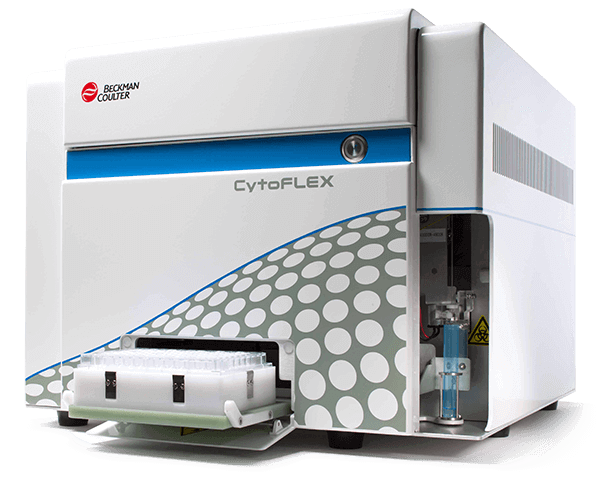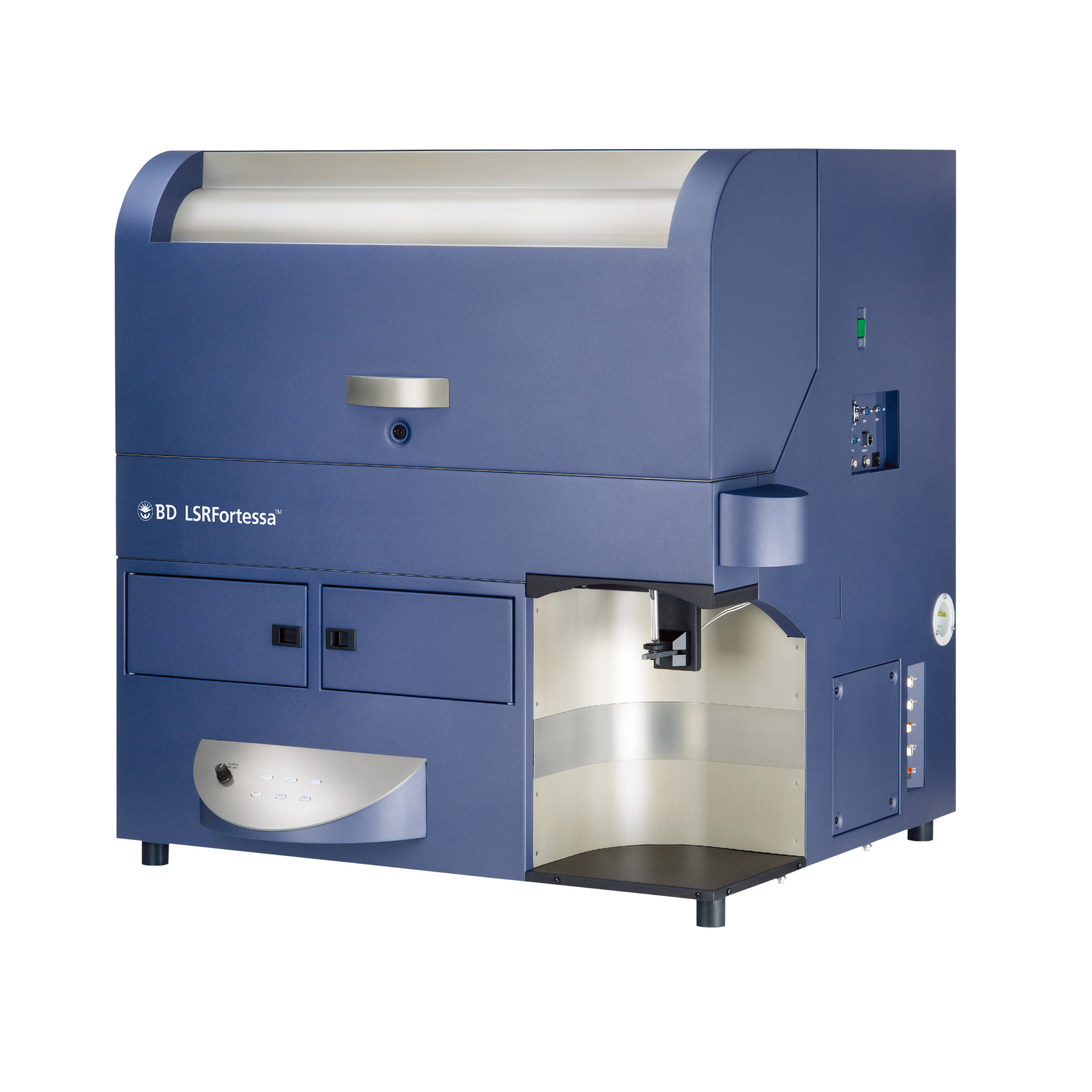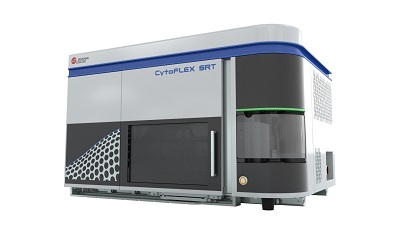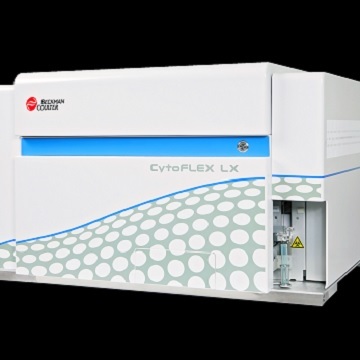方案详情
文
药物靶点鉴定是发现和开发安全有效疗法的关键步骤。能量代
谢通常被认为仅提供“管家”功能,但是现在正成为影响许多
细胞功能的关键因素。代谢功能障碍也与越来越多的不同疾病
状态相关。因此,研究调控能量代谢的基因、蛋白质和通路是
一种有希望用于开发各种疾病新型治疗策略的新途径。
方案详情

Trusted Answers 神经退行性疾病 用于新型治疗策略的代谢靶标 药物靶点参考指南 Aa isTest aMsp SPM E ECA 37.0C ugria 细胞代谢一药物发现的新途径 药物靶点鉴定是发现和开发安全有效疗法的关键步骤。能量代谢通常被认为仅提供“管家”功能,但是现在正成为影响许多细胞功能的关键因素。代谢功能障碍也与越来越多的不同疾病状态相关。因此,研究调控能量代谢的基因、蛋白质和通路是一种有希望用于开发各种疾病新型治疗策略的新途径。 这一简便的参考指南提供了影响以下关键疾病领域的代谢靶标示例: 癌症和免疫肿瘤学 神经退行性疾病 获得性代谢紊乱,包括糖尿病和心血管疾病 我们希望本指南能够激发您通过能量代谢这一全新视角重新审视治疗策略。如需了解如何将用于测量能量代谢的安捷伦解决方案纳入您的靶标鉴定工作流程,请单击此处: www.agilent.com/chem/drugdiscovery-cellmetabolism 能量代谢的改变现已被视为癌症的标志“。因此,对影响代谢通路的靶标的鉴定为可能有效的癌症疗法提供了关键见解。 研究人员在确定癌细胞中的药物靶点方面已经取得了重大进展,其中着重强调了代谢中间体是癌症药物发现中的关键靶标。 靶标:致癌基因、相关分子靶点和和代谢通路 致癌基因负责将癌细胞能量代谢改编为倾向于生物质积累和糖酵解能量产生,而非非增殖性细胞中发生的线粒体能量产生。致癌基因通路中间体(包括基因、蛋白质和酶)代表了有前景的癌症治疗靶标。 靶标:营养物质输送和利用 为支持生物质积累,癌细胞增加了对肿瘤微环境中的底物和营养物的摄取。潜在的代谢靶标主要能够抑制或激活与底物和营养物质输送或利用相关的基因、蛋白质和通路。 靶标:免疫肿瘤学 肿瘤微环境中包括一系列不同的细胞类型,包括基质成纤维细胞、神经胶质细胞、巨噬细胞、骨髓衍生的肿瘤抑制细胞以及肿瘤耐受的T细胞和B细胞,这些细胞可以驱动或抑制肿瘤的形成和维持。代谢在免疫肿瘤学中驱动免疫细胞激活、增殖、归趋和功能,使代谢中间体成为肿瘤微环境中的关键靶标。 表1列出了几种有癌症治疗前景的代谢靶标。这些代谢靶标的开发阶段和有效性范围从临床前延伸到临床以及临床后,并代表了药物靶点鉴定和验证的机会区域。 靶标ID 通路/功能 描述 参考文献 GLUT1 糖酵解,葡萄糖转运 葡萄糖转运蛋白 1 xCT 谷氨酰胺,谷氨酸代谢一胱氨酸获得,用于 GSH合成 由SLC7A11 基因编码的胱氨酸-谷氨酸逆向转运蛋白 2 MCT1 乳酸代谢 由SLC16A1基因编码的单羧酸转运蛋白 3-5 GAPDH 糖酵解 糖酵解酶 6 LDHA 糖酵解, NAD/NADH 平衡 糖酵解酶,催化丙酮酸-乳酸转化 7-12 GLS 谷氨酰胺代谢 酰胺水解酶,催化谷氨酰胺-谷氨酸转化 13-17 CPT1 长链脂肪酸转运/氧化 线粒体酶,催化长链脂肪酰辅酶A的酰基从辅酶A转移到左旋肉碱 18 PDK1 丙酮酸代谢/氧化 激酶,调节PDH 19 MGLL 脂肪酸合成 催化脂肪酸合成 20 HIF1 调节中枢低氧反应 低氧诱导转录因子 21 mTOR 调节细胞增殖、转录、翻译和自噬 由 MTOR 基因编码的激酶 22-23 有癌症治疗前景的代谢靶标 神经退行性疾病 线粒体功能障碍已被认为是导致神经退行性疾病的最常见原因,其主要与呼吸功能障碍(OXPHOS) 和通路中间体相关。鉴定影响线粒体代谢功能的特定蛋白质,有助于了解神经退行性疾病的潜在药物靶点。 线粒体是负责产生能量(ATP)和调节对细胞稳态至关重要的其他几个过程的细胞“发电厂”。神经细胞的能量需求高,且具有有限的再生能力;因此,这些细胞的存活高度依赖线粒体功能。事实上,越来越多的证据表明,线粒体蛋白和线粒体功能障碍是神经退行性疾病发病的原因,包括阿尔兹海默病、帕金森病、亨廷顿氏病和肌萎缩侧索硬化症 (ALS)。 靶标:线粒体功能障碍中的线粒体蛋白和中间体 测量代谢通路活性和中间体的研究表明,线粒体功能障碍是引起神经退行性疾病的主要原因。代谢靶标和关键驱动因素归因于:遗传突变(mtDNA突变)、线粒体膜通透性和膜电位破坏、线粒体融合或裂变破坏、蛋白质和离子稳态受损、活性氧或者有毒聚集体的积累以及线粒体自噬功能失调。 表2列出了一些已作为神经退行性疾病的潜在靶点得到研究的线粒体蛋白质。与神经退行性疾病中的其他药物靶点相比,线粒体蛋白代表了相对较新的药物开发靶点。尽管以线粒体蛋白为靶点的疗法进入临床试验阶段的很少,但它们代表了一个有前景的新靶点领域。 靶标ID 通路/功能 描述 疾病 参考文献 CypD 线粒体功能/健康 肽基脯氨酰异构酶F,在线粒体膜通透性转换过程(mPTP形成)中与线粒体内膜结合 阿尔兹海默病、帕金森病、肌萎缩侧索硬化症(ALS) 24-26 PINK1 PInk1/Parkin 通路,线粒体自噬 线粒体特异性激酶 PTEN 诱导激酶1 帕金森病 27 LRRK2 细胞质 GTP 酶和激酶活性 富亮氨酸重复受体激酶家族的成员 帕金森病 28-30 Drp-1 线粒体自噬 调节线粒体分裂的 GTP酶 帕金森病 31-32 DJ-1 细胞氧化应激反应 氧化还原敏感的分子伴侣/氧化应激传感器,由 PARK7基因编码 帕金森病 33 ABAD 异亮氨酸、支链脂肪酸、外源性物质、性激素和神经活性类固醇的氧化 由 HSD17B10基因编码的线粒体酶 阿尔茨海默病 34-37 MPC 丙酮酸氧化 线粒体丙酮酸载体 由兴奋性损伤引起的神经退化 38 SOD1 细胞中ROS的破坏 可溶性细胞质和线粒体膜间隙酶,由SOD1编码 肌萎缩侧索硬化症(ALS) 39-40 有前景的神经退行性疾病代谢靶标的示例 糖尿病、心血管病及其他获得性代谢紊乱 营养物质过剩和压力过大的相关环境因素是肥胖的主要驱动因素,进一步导致并发症的出现,包括2型糖尿病和心血管疾病。调控代谢靶标以恢复能量稳态平衡至“正常”,代表了用于逆转或预防这些破坏性综合征有前景的治疗策略。不同组织使用不同的营养物质来满足它们的能量需求。过量营养物质和底物可用性或长期暴露于错误的底物平衡会产生一系列影响,包括脂肪组织增加、炎症和胰岛素抵抗。鉴定具有能量底物摄取和利用活性的蛋白质(包括代谢通路和中间体)是潜在的药物靶点来源。 靶标:脂质与葡萄糖代谢和胰岛素抵抗 作为能量来源的脂质代谢和葡萄糖代谢之间存在负反馈。脂肪酸氧化与葡萄糖氧化(包括线粒体解偶联减少)之间的能量平衡受能量底物摄取和利用中的活刮蛋白质的影响。 糖尿病、心血管病及其他获得性代谢紊乱 表3列出了先前已作为与肥胖、糖尿病和心血管疾病相关代谢紊乱的潜在靶标得到研究的蛋白质。 靶标ID 通路/功能 描述 参考文献 PPARa 控制参与脂肪酸摄取和细胞内转运、脂肪酸氧化、脂肪生成、生酮作用和脂蛋白/ 胆固醇代谢(在脂肪细胞中)的(肝)基因的表达 配体活化的核受体/转录因子 41 PPARy 调节ADD、功能、胰岛素敏感性、脂肪生成、脂质储存和葡萄糖代谢 配体活化的核受体/转录因子 42 AMPK AMPK活化刺激肝/骨骼脂肪酸氧化、酮生成和葡萄糖摄取,抑制FA合成、脂肪 生成,并调控胰岛素分泌 ADP 活化的蛋白激酶,是细胞能量稳态中的关键酶 43 GLUT4 糖酵解/葡萄糖氧化 胰岛素调节的葡萄糖转运蛋白 44、45 CPT1 长链脂肪酸转运/氧化 线粒体酶,催化长链脂肪酰辅酶A的酰基从辅酶A转移到左旋肉碱 43 MPC 丙酮酸氧化 线粒体丙酮酸载体,调节能量平衡和代谢特征的治疗靶标 46 UCP ETC/OXPHOS 棕色脂肪组织中的中粒体蛋白,从 OXPHOS 中解偶联 ETC 47 用于糖尿病、心血管和其他获得性代谢紊乱的有前景代谢靶标的示例 实用资料 DrugBank 数据库是一个公共数据库,提供独特的生物信息学和化学信息学资源,将详细的药物数据与完善的药物靶点信息相结合。 治疗靶标数据库 (TTD) 是一个公共数据库,提供有关已知和已探索的治疗蛋白质和核酸靶标、靶向疾病、通路信息以及针对这些靶标的相应药物的信息。 CenterWatch 是一个临床试验数据库,基于当前的临床试验确定药物开发的趋势。 KEGG 疾病数据库包括一系列疾病条目,仅关注干扰因素,提供对大多数疾病来说未知的分子网络的详细信息。 1 Chan, D.A. et al.(2011) Targeting GLUT1 and the Warburg effect in renal cell carcinoma by chemicalsynthetic lethality. Sci. Transl. Med. 3, 94ra70 2 Timmerman, L.A. et al.(2013) Glutamine sensitivity analysis identifies the xCT antiporter as a commontriple-negative breast tumor therapeutic target. Cancer Cell. 24, 450-465 .3 Polanski, R. et al. (2014) Activity of the monocarboxylate transporter 1 inhibitor AZD3965 in small celllung cancer. Clin. Cancer Res. 20, 926-937 4 Birsoy, K. et al. (2013)MCT1-mediated transport of a toxic molecule is an effective strategy fortargeting glycolytic tumors. Nature Genet. 45, 104-108 5 Sonveaux, P. et al. (2008) Targeting lactate-fueled respiration selectively kills hypoxic tumor cells inmice. J. Clin. Invest. 118,3930-3942 6 Ganapathy-Kanniappan, S. et al.(2013) Anticancer efficacy of the metabolic blocker 3-bromopyruvate:specific molecular targeting. Anticancer Res. 33, 13-20 / Boudreau, A. etal. (2016) Metabolic plasticity underpins innate and acquired resistance to LDHAinhibition. Nat. Chem. Biol. 12,779-786 8 Cui, W.et al. (2016) Discovery of 2-((3-cyanopyridin-2-yl)thio) acetamides as human lactatedehydrogenase A inhibitors to reduce the growth of MG-63 osteosarcoma cells: virtual screening andbiological validation. Bioorg. Med. Chem. Lett. 26, 3984-3987 9 Billiard, J. et al.(2013) Quinoline 3-sulfonamides inhibit lactate dehydrogenase A and reverse aerobicglycolysis in cancer cells. Cancer Metab. 1, 1-19 ( 10. R ai, G. et al . (2017) Discovery and optimization of potent, c e ll active pyraz o le-based inhibitors of lactate dehydrogenase(LDH). J. M ed. Chem. 6 0(22):9184-920 4 ) ( 11. W ard,R . A. e t al. (2012) Design and synthesis of novel lactate d ehydrogenase A inhibitors by fragment-based lead generation. J. Med. Chem. 5 5, 3285-3306 ) ( 12. L e, A. et al.(2010) Inhibition o f lactate dehydrogenase A induces oxidative stres s and inhibi t s tumorprogression. P roc. Natl. Acad. Sci . 107,2037-2042 ) 13. Xiang, Y. et al. (2015) Targeted inhibition of tumor-specific glutaminase diminishes cell-autonomoustumorigenesis.J. Clin. Invest.125,2293-2306 14. Shroff, E.H. et al.(2015) MYC oncogene overexpression drives renal cell carcinoma in a mouse modelthrough glutamine metabolism. Proc. Natl. Acad. Sci. 112, 6539-6544 15. Gross, M.l. et al. (2014) Antitumor activity of the glutaminase inhibitor CB-839 in triple-negative breastcancer. Mol. Cancer Ther. 13,890-901 16. Wang,J. B. et al. (2010) Targeting mitochondrial glutaminase activity inhibits oncogenictransformation. Cancer Cell 18, 207-219 17. Seltzer, M. J. et al. (2010) Inhibition of glutaminase preferentially slows growth of glioma cells withmutant IDH1. Cancer Res. 70,8981-8987 18. Pike, L. S. et al.(2011) Inhibition of fatty acid oxidation by etomoxir impairs NADPH production andincreases reactive oxygen species resulting in ATP depletion and cell death in human glioblastomacells. Biochim. Biophys. Acta 1807, 726-734 ( 19. M ichelakis,E. D ., Webster, L. & Mackey, J. R. (2008) D i chloroacetate (DCA) as a p o t e ntial metabolic-targeting therapy for cancer. Br. J. Cance r 99, 989-994 ) ( 20. N omura,D. K. et al. ( 2010) Monoacylglycerol lipase regulates a fatty acid network that promotescancer pathogenesis. Cell 140,49-61 ) ( 21. W ilson,W. R. & Hay, M. P . (2011) Targeting hypoxia in cancer therapy. Nature Rev. Cancer 1 1,393-410 ) ( 22. S abatini, D. M. (2006) mTOR and cancer: in s ights into a complex re l ationship. Nature Rev. Cancer 6, 729 - 734 ) ( 23. B enjamin, D. e t al. (2011) Rapamycin passes the torch: a n e w generation of mTOR in h ibitors. NatureRev. D rug Discov. 10,868-880 ) 24. Guo, H. X. et al.(2005) Novel cyclophilin D inhibitors derived from quinoxalineexhibit highly inhibitoryactivity against rat mitochondrial swelling and Ca2+ uptake/release Acta Pharmacol. Sin. 26, 1201-1211 25. Valasani, K.R. et al. (2014) Design, synthesis, in silico and in vitro studies of novel 4-methylthiazole-5-carboxylic acid derivatives as potent anti-cancer agents Bioorg. Med. Chem. Lett. 24(18), 4580-4585 26. Elkamhawy, A. et al. (2014) Novel quinazoline-urea analogues as modulators for AB-inducedmitochondrial dysfunction: design, synthesis, and molecular docking study. Med. Chem. 84,466-475 ( 27. H ertz, N. T . et al. (2013) A neo-substrate that amplifies catalytic activity of parkinson' s -disease - related kinase PINK1. C ell. 154,737-747 ) ( 28. L i, T. eta l . (2015) A Nove l GTP-Binding Inh i bitor, FX2149 , Attenuates L RRK2 Toxicity in Parkinson’sDisease Models. PLoS One. 10,e0122461 ) 29. Li, T. & Yang, D. et al. (2014) Novel LRRK2 GTP-binding inhibitors reduced degeneration in Parkinson'sdisease cell and mouse models. Hum. Mol. Genet. 23,6212-6222 30. Estrada, A. A. et al.(2014) Discovery of highly potent, selective, and brain-penetrant aminopyrazoleleucine-rich repeat kinase 2 (LRRK2) small molecule inhibitors. Med. Chem. 57, 921-936 ( 3 1. Qi, X. e t al. (2013) A novel D rp1 i n h ibitor diminishes ab e rrant mit o chondrial fission and neurotox i city. Cell Sci . 126,789-802 ) 32. Lackner, L. L. & Nunnari, J. (2010) Small molecule inhibitors of mitochondrial division: tools thattranslate basic biological research into medicine. Chem. Biol. 17, 578-583 ( 33. K itamura, Y . e tal.(2011) Neuroprotective effect of a new D J -1-binding compound againstneurodegeneration in P arkinson's disease and s troke model rats. Mol. Neurodegener. 6(48), 1 -19 ) ( 34. K issinger, C. R. et al. (2004) M olecular dynamics simulations o f t he amyloid-beta binding alcoholdehydrogenase (ABAD) e n zyme. Mol. Biol. 16(21), 9511-9518 ) 引用参考文献(续) 35. Lim, Y. A. et al. (2011) Inhibition of the mitochondrial enzyme ABAD restores the amyloid--mediatedderegulation of estradiol. PLoS One. 6, e28887 36. Valaasani, K. R. et al. (2014) Identification of human ABAD inhibitors for rescuing AB-mediatedmitochondrial dysfunction. Curr. Alzheimer Res. 11, 128-136 37. Ayan, D., Maltais, R., & Poirier, D. (2012) Identification of a 17B-hydroxysteroid dehydrogenase type 10steroidal inhibitor: a tool to investigate the role of type 10 in Alzheimer's disease and prostate cancer.ChemMedChem. 7,1181-1184 38. Divakaruni, A. S. et al. (2017) Inhibition of the mitochondrial pyruvate carrier protects from excitotoxicneuronal death. J Cell Biol.4, 1091-1105 39. Kalmar, B. et al. (2008) Cellular toxicity of mutant SOD1 protein is linked to an easily soluble, non-aggregated form in vitro. Neurobiol Dis. 49, 49-56 40. Lange,D. J. et al.(2013) Pyrimethamine decreases levels of SOD1 in leukocytes and cerebrospinal fluidof ALS patients: a phase l pilot study. Amyotroph Lateral Scler Frontotemporal Degener. 14(3),199-204 41. Han et al. (2017) PPARs: regulators of metabolism and as therapeutic targets in cardiovasculardisease. Part I: PPAR-a. Future Cardiol. 13(3),259-278 42. Han, L. et al. (2017) PPARs: regulators of metabolism and as therapeutic targets in cardiovasculardisease. Part II: PPAR-B/6 and PPAR-y. Future Cardiol. 13(3), 279-296 43. Fukushima, A. et al.(2015) Myocardial Energy Substrate Metabolism in Heart Failure : from Pathwaysto Therapeutic Targets. Current Pharmaceutical Design. 21, 3654-3664 44. Schreiber, l. et al. (2017) BMPs as new insulin sensitizers: enhanced glucose uptake in mature 3T3-L1adipocytes via PPARgamma and GLUT4 upregulation. Sci Rep. 7 (1),17192 45. Bhowmik, A. & Banu, S. (2017) Therapeutic targets of type 2 diabetes: an overview. MOJ Drug DesDevelop Ther. 1(3),00011 46. Divakaruni, A, S. et al. (2013) Thiazolidinediones are acute, specific inhibitors of the mitochondrialpyruvate carrier. PNAS. 110 (14),5422-5427 47. Samudio, I. et al. (2009) Mitochondrial Uncoupling and the Warburg Effect: Molecular Basis for theReprogramming of Cancer Cell Metabolism. Cancer Res. 69(6), 2163-2166 48. Hanahan, D., & Weinberg, RA. (2011) Hallmarks of Cancer: The Next Generation. Cell. 144(5), 646-674 49. Lee, J.(2016) Mitochondrial drug targets in neurodegenerative diseases. Bioorganic & MedicinalChemistry Letters. 26,714-720 www.agilent.com/chem/drugdiscovery-cellmetabolism 实时交流 www.agilent.com/chem/discoverXF 安捷伦客户服务中心: 免费专线:800-820-3278 400-820-3278(手机用户) 欧洲 英国0800096 丹麦4588305083 德国08001806678 荷兰08000227243 其他欧盟国家45 3136 9878 info_agilent@agilent.com 亚太地区 中国800 820 3278 新加坡6565710888 inquiry_Isca@agilent.com ( 仅限研究使用。不可用于诊断目的。 ) ( 本文中的信息、说明和指标如有变更,恕不另行通知。 ) ( ◎安捷伦科技(中国)有限公司,2018 ) 这一简便的参考指南提供了影响以下关键疾病领域的代谢靶标示例:- 癌症和免疫肿瘤学- 神经退行性疾病- 获得性代谢紊乱,包括糖尿病和心血管疾病
确定







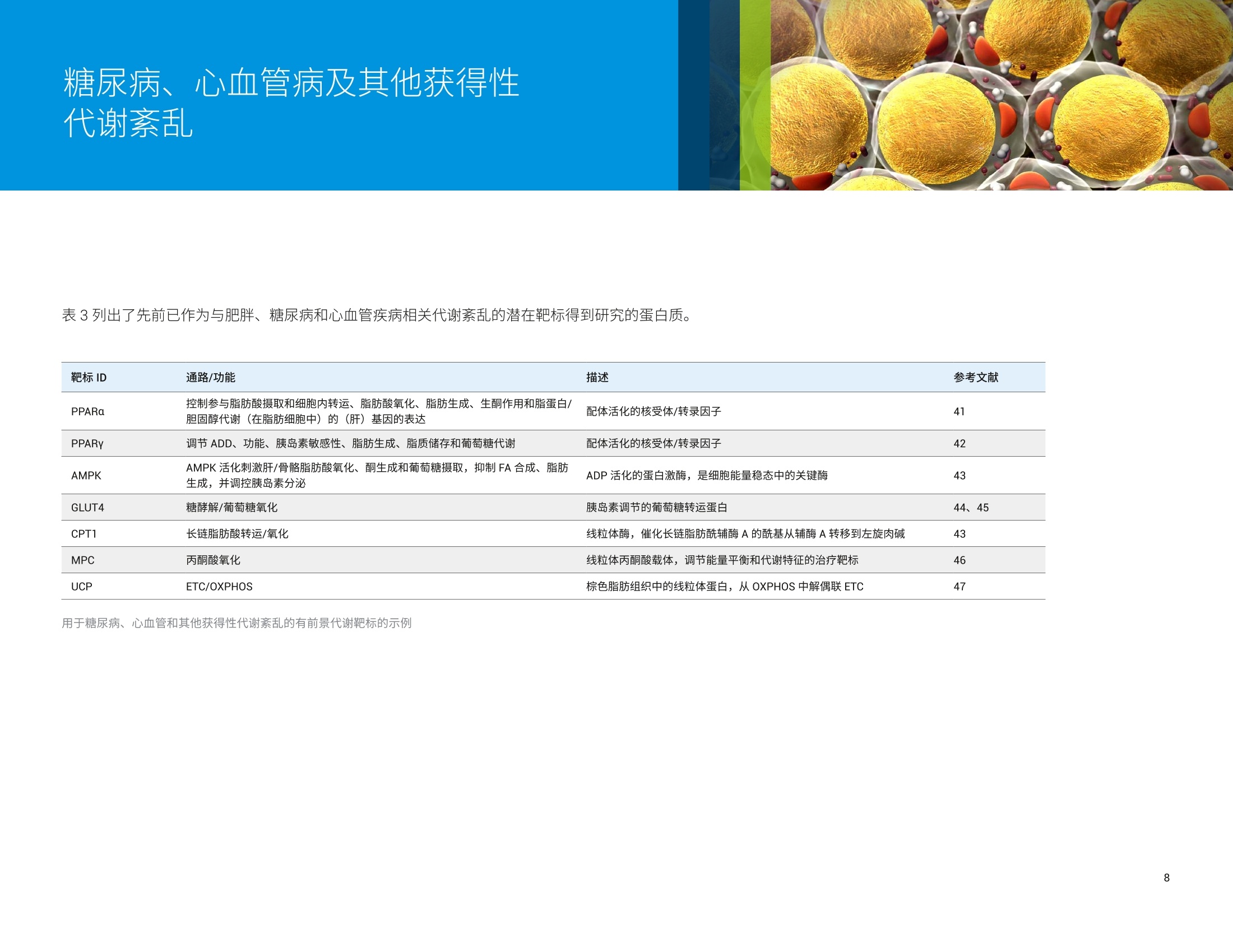

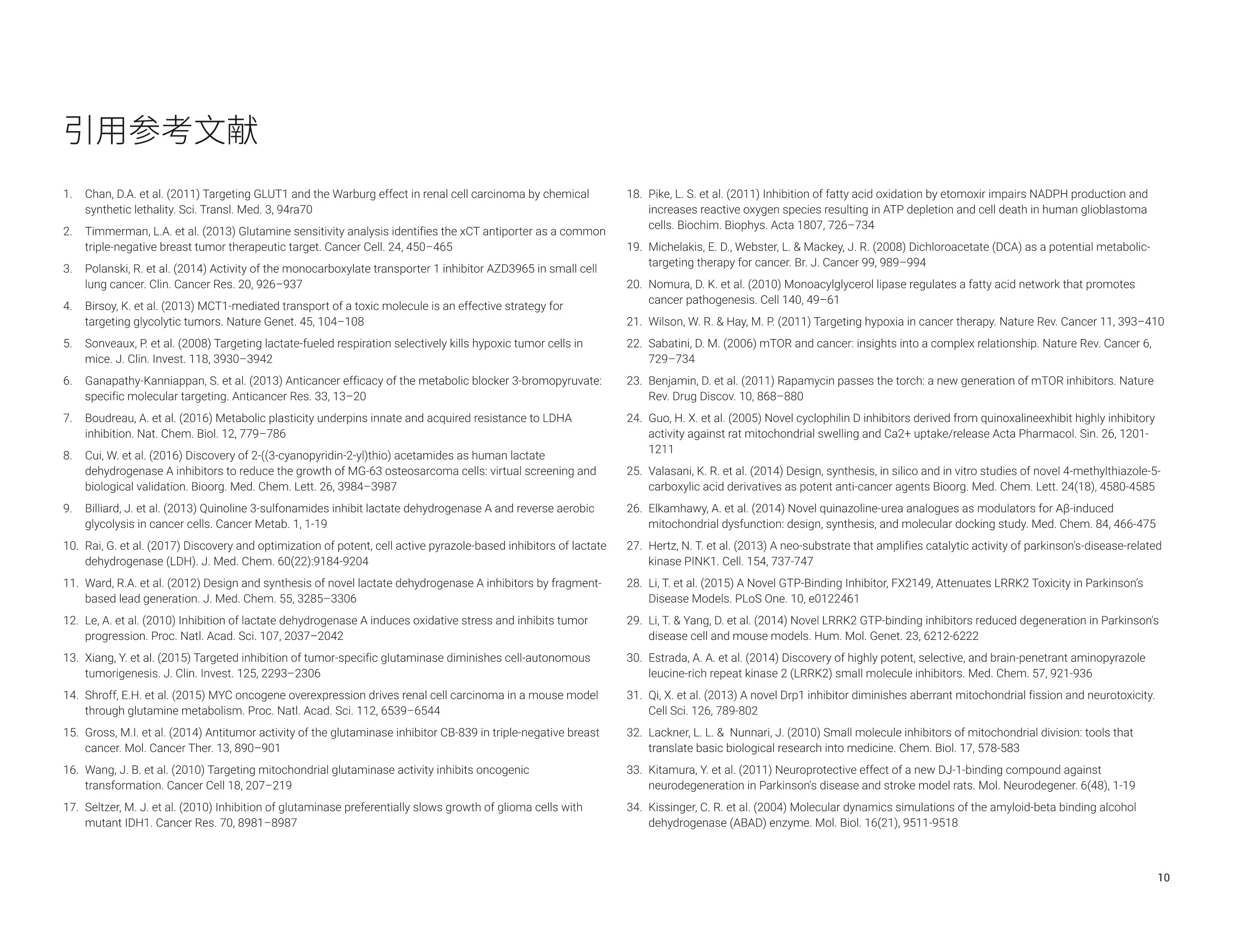


还剩10页未读,是否继续阅读?
安捷伦Seahorse为您提供《细胞中细胞代谢靶标药物靶点检测方案(流式细胞仪)》,该方案主要用于上皮脱落细胞中生化检验检测,参考标准--,《细胞中细胞代谢靶标药物靶点检测方案(流式细胞仪)》用到的仪器有安捷伦Seahorse XFp 细胞能量代谢分析仪
推荐专场











